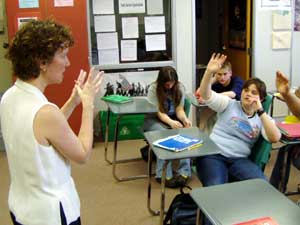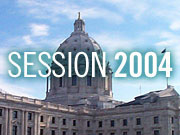Audio
Photos
Your Voice
| ||||||||||||||||||||||||||||||||||||||||||||||||||
Bridging the great social studies divide
May 11, 2004
 |
| JoEllen Ambrose discusses the legislative branch of government in her ninth grade civics class at Champlin Park High School. (MPR Photo/Tim Pugmire) |
Champlin, Minn. — In a ninth grade civics class at Champlin Park High School, students are learning about the legislative branch of government and how a bill becomes law. JoEllen Ambrose has taught civics and government for 25 years. She says she didn't like what the Minnesota House approved as statewide social studies standards, because it doesn't fit with the classes she teaches. Ambrose says the lists of facts students would have to learn are too long and limiting.
"It eliminates tons of choices that local districts will be able to make in what's taught," Ambrose said.
Ambrose joined other educators in developing the alternative social studies standards approved by the Minnesota Senate. She says those grade-by-grade expectations strike a better balance between factual knowledge, and the need for students to analyze information and think critically.
 | |||
"I take very seriously my role as a teacher in engaging students in the work that they're doing, Ambrose said. "Because I think good learning comes from the fact that students have some interest and some motivation. Then you can steer them into the area, where the interest drives the learning. Then they can learn the content."
But critics say the Senate plan doesn't reflect the back-to-basics approach to learning outlined last year in the legislation that repealed the Profile of Learning standards. The Profile system often emphasized the learning process over content. Julie Quist of the group EdWatch, formerly the Maple River Coalition, fought hard against the Profile. She claims the Senate standards preserve that same flawed approach.
"Instead of learning history, you learn how to do history," Quist said. "Instead of learning government, you learn how to be an activist. And it's a completely different approach to education and to what's true about who we are."
Quist says the House standards better reflect mainstream Minnesota and place greater emphasis on America's founding principles.
But some educators say the House standards are full of historic holes, such as little attention to Latin America. Lisa Norling, a history professor at the University of Minnesota, says the Senate standards she helped write present a more balanced view of history. Norling says they also include a key outline for teachers.
 | |||
"A sheer list of facts, whether it's geographic facts or historical facts or facts in government and civics or economics -- they don't stick in your brain and they don't make any sense unless you have a theoretical framework, a conceptual framework to understand why those facts and not others," Norling said. "Why that set of facts is meaningful, has significance, is worth learning."
The Senate standards also take a slower approach, expecting students in the early grades to compare family life in their own communities from earlier times and today. The House version requires first-graders to know specific historical figures and their contributions.
University of Minnesota history professor James Tracy prefers the more rigorous approach of the House standards. Tracy says he doesn't buy the philosophy that says younger students learn better if they start with subjects close to home.
"These are kids who can, depending on what they're exposed to, they can draw you a map of the kingdom of Mordor, or the can tell you the history of the Jedi knights," Tracy said. "They have an active fantasy, and they're used to the idea of worlds being constructed. And I don't really see how it's all that different to have them construct at a second or third grade level the world of Greece and Rome, or whatever else is appropriate."
Supporters of each version of the social studies standards say they doubt lawmakers can successfully blend the competing documents into one. They favor a choice be made between the distinct approaches, or delaying the decision until next year. Legislators faces a May 17 deadline for adjournment.
|
News Headlines
|
Related Subjects
|

